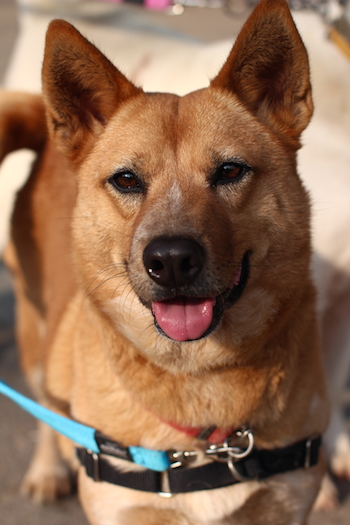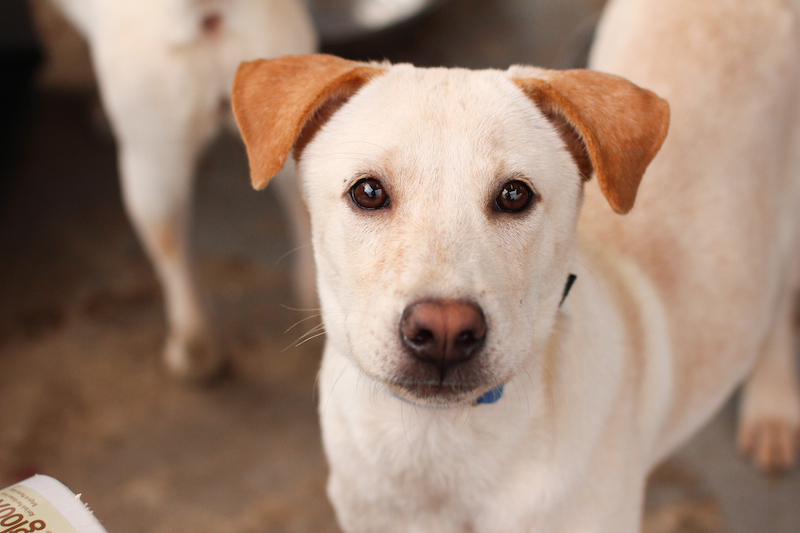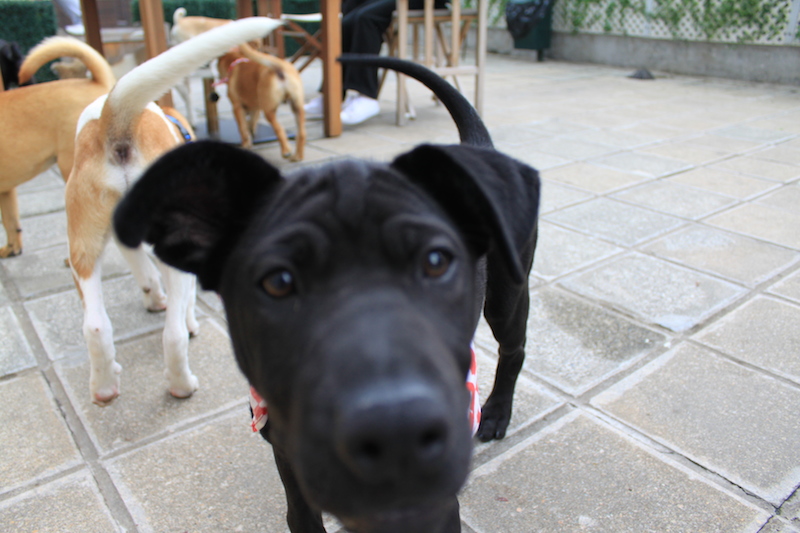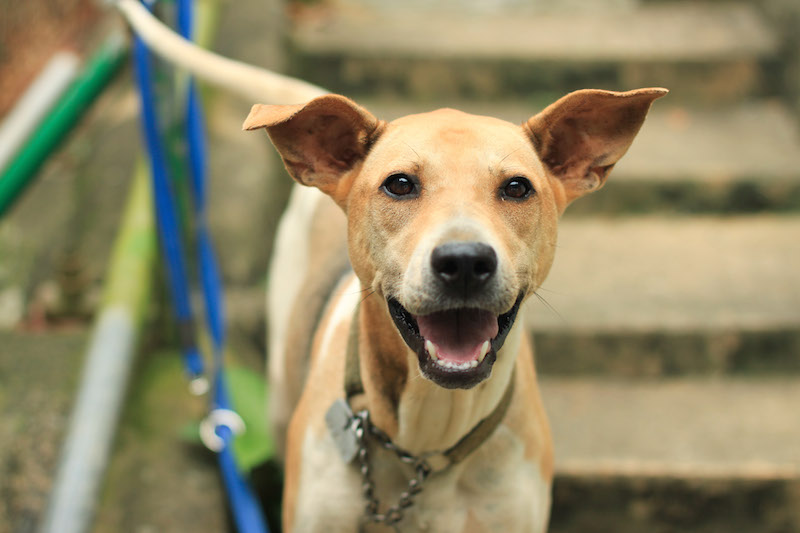Having travelled extensively in Southeast Asia, I’ve become accustomed to seeing the occasional wild, collarless dog (or ten) roaming any given city’s streets. Unkempt, flea-ridden and rather threatening in appearance, these dogs rarely attract the loving attention of, say, a six-month-old Labrador puppy.
The streets of Hong Kong show quite a different scene, however, due in large part to the Hong Kong government’s Agriculture, Fisheries, and Conservation Department (AFCD). You’re unlikely to see a stray strolling through the streets of Central because most have been locked up in a government kennel somewhere.

Once that happens, the pup has four days to be adopted or face the canine gallows. That’s the fate that the AFCD inflicts on about 10,000 dogs in Hong Kong each year.
Lamma resident Sally Andersen began to take in the island’s strays around 30 years ago. With no intention of starting anything grand, she spent many years doing her part independently for the canine community, fuelled only by her own belief in the cause.
Upon a visit to a government kennel in 2003, however, Sally discovered that the four-legged inmates could only be released to a registered NGO in Hong Kong and not an individual. Inspired rather than deterred, she founded Hong Kong Dog Rescue (HKDR).

Sally Andersen. (Photo: Semirah Darwin)
Since its inception, HKDR has saved over 7,500 doomed dogs and puppies by taking them in and readying them for adoption. There are around 10 full-time staff members at the helm, but the backbone of the organisation is comprised of the 1,200+ volunteers who feed, walk, and attend to these dogs on a daily basis.
At the heart of HKDR’s philosophy is its “no kill” policy. “No dog under our care will be euthanised for any reason other than when it is the only humane option,” the organisation asserts. “Our pledge to every dog is a home for life.”
Many dogs will be rescued, rehabilitated and re-homed in a matter of weeks, but others may stay at the HKDR kennels for years. While adoption is always the primary goal, the passionate people at the HKDR make the intermediary stay a comfortable one, no matter how long.

The age and size of a dog inevitably impacts on its chances of adoption, but according to Eva Sit, the communications and assistant manager of the organisation’s Tai Po Homing Centre, it’s often the breed of the dog, or lack of, that can be its Achilles’ heel.
The local mixed breed, known in Chinese as “tong gau”, in the New Territories are trained to guard their owners and generally have poor socialisation with humans; the barking and antisocial behaviour paints a negative picture of “tong gau” in general among locals.

A typical mixed-breed Hong Kong dog. Photo: Yaki Yan
“Many people get the wrong impression that all mixed-breed dogs are scary and some do not see them suitable at all as family pets,” Sit says. “This perception is totally unfair. Most of the sweetest-natured dogs we have are multi-breed, and they are so loving and gentle.”
It comes down to a crucial need to change the anti-adoption culture that many Hong Kong dog owners perpetuate. Pedigree dogs from the pet stores continue to be preferred over equally beautiful, well-behaved “tong gau” with tragic histories.

Adoption not only takes a dog off the streets, but frees up more space for rescue organisations like the HKDR to take in more tenants. “One dog adopted, two lives saved,” as Sit puts it.
The HKDR does not own the land it occupies, and is therefore in a permanently precarious position. The resolve of the organisation was seriously tested in 2010 when the government evicted humans and dogs alike from its Pokfulam premises.
Persistence and a willing group of volunteers facilitated the move of more than 100 variously sized dogs to an isolated part of Tai Po, the HKDR’s current headquarters.

From the red line, to the green line, to the light blue East Rail line, it’ll take Hong Kong Islanders almost an hour to reach Tai Wo, the nearest MTR station to the rescue centre.
Then there’s a subsequent 10-minute climb up an Everest-like slope. You only know you’re in the right place thanks to the symphony of barking that eventually leads you to the unglamorous, unadorned metallic gates of the Tai Po Homing Centre, the stomping ground of HKDR’s bigger, more energetic dogs.
The facility plays host to more than 400 dogs, a far higher capacity than the 170-kennel Pokfulam facility.
Roni Chow, one of the organisation’s regular volunteers, positively gushes about the animals to which she devotes every Sunday afternoon. “Once you step in that gate, all you can see is just wagging tails and smiling faces. You are happy once you see the dogs are happy.”

Every dog is given a name and categorised with a green, yellow or red label to indicate its temperament and needs. They are cared for in the most personal way possible, and while the facility may not simulate a home environment, the volunteers provide a loving stay for these animals… and the affection and appreciation is returned twofold.
“They are just like my family,” says Chow of the dogs. “I’m totally addicted to this pure world that is surrounded with love.”
The smaller, more fragile dogs such as the poodles, pugs and chihuahuas reside in the much more compact HKDR facility in Ap Lei Chau. The 40-odd dogs housed here are much more accessible for potential adopters, no doubt largely helped by the presence of the HKDR Education Centre opposite, where the dogs’ behavioural problems are corrected with positive reinforcement techniques.
Rescued puppies live on Lamma in the personal care of Sally Andersen, with many more in foster homes with volunteers helping to prep the pups for life after adoption.

Participants in The Peak sponsored walk. (Photo: HKDR)
The HKDR receives no aid from the government. According to its most recent 2013 report, around 41 percent of funding comes from private donations, six percent from merchandise sales, and 12 percent from special grants. But most important are the HKDR’s fundraising events, which account for around 25 percent of budget and bring the organisation and its hopeful hounds important exposure… and some much needed fun.
Such events include the annual Disney-sponsored November Peak to Fong Sponsored Walk, gala dinners and Puppy Adoption Sundays, the latter of which are held every week at Whiskers N Paws in Horizon Plaza, Ap Lei Chau.

As HKDR has grown, it’s become as much about snuffing out the problem at its source as it is about saving existing dogs. Many of the thousands of homeless, injured, and abused dogs in Hong Kong are a result of irresponsible and ignorant pet ownership.
Education on de-sexing, vaccinations, and behavioural traits can go leaps and bounds to ensure a happy marriage between a family and its newest four-legged member. The organisation has already taken steps to deliver the necessary knowledge to future pet owners by giving talks on animal welfare in schools, reaching over 3,500 students.

The strict vetting of potential adoptees also forces people to be rational about what they can and can’t handle when it comes to a pet. Cactus Mok, HKDR’s education and training manager, even follows up on all adoptions to make sure the grass really is greener on the post-kennel life side.
Every year, 520 dogs are adopted into loving hands thanks to HKDR, but there are some truly beautiful, gentle dogs still awaiting a permanent home. Now, it’s about convincing a society so mired in its misconceptions that these abandoned strays deserve a life as much as the pedigrees in pet store windows.

Take a dog like Alison home! (Photo: Vicki Chu)




Reader Interactions